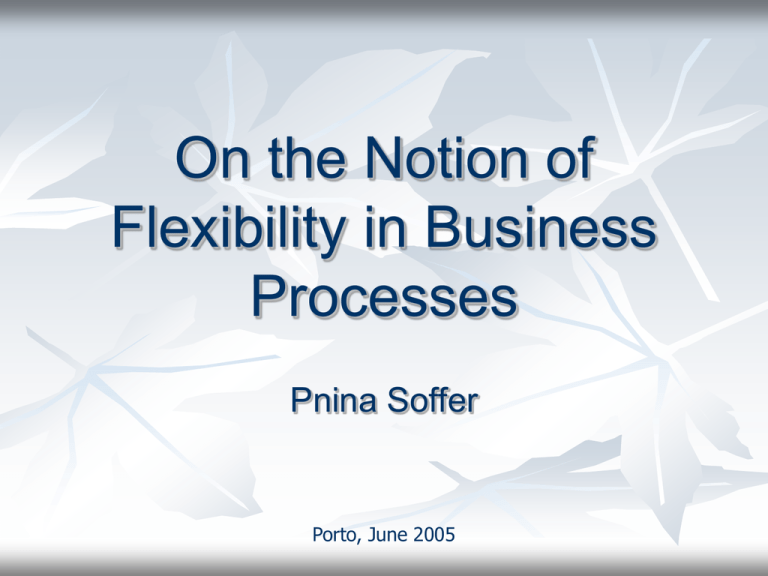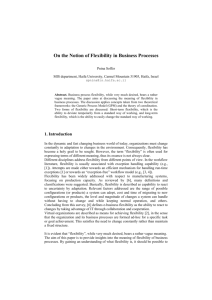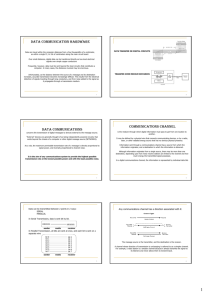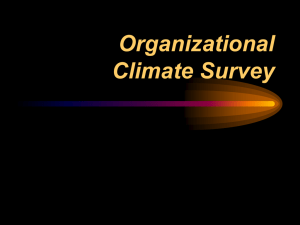On the Notion of Flexibility in Business Processes
advertisement

On the Notion of Flexibility in Business Processes Pnina Soffer Porto, June 2005 Business process flexibility: What does it mean? Two types of BP flexibility Short term flexibility Capability to deviate from a standard way of working Long term flexibility Capability to change the standard way of working Theoretical background: The Generic Process Model (GPM) A process: a sequence of unstable states transforming by law until a stable state is reached. Process goal: a set of stable states on which the process terminates. Defined by a condition that specifies what the process is to achieve. Domain law: Mappings between subsets of states, specifying possible transformations. Theoretical background: The theory of coordination Coordination: the management of dependencies Dependency types: Flow dependency Sharing dependency Fit dependency Short term flexibility Ability to achieve the process goal via multiple paths. In flexible BPs the law imposes a minimal set of constraints Constraints should be distinguished to essential and inessential. Constraint classification Environmental constraints Goal reachability constraints BPS system imposed constraints Sharing dependency related constraints Soft-goal related constraints Environmental constraints Constraints imposed by the environment Legislation Location Technology Market Cannot be eliminated or bypassed in the short term Constraint classification Environmental constraints Goal reachability constraints BPS system imposed constraints Sharing dependency related constraints Soft-goal related constraints ESSENTIAL Goal reachability constraints Source: process interaction, where an outcome of one process is required for another process to attain its goal. Example: inventory management process and production process. Cannot be eliminated if all goals are to be reached. Constraint classification Environmental constraints ESSENTIAL Goal reachability constraints ESSENTIAL BPS system imposed constraints Sharing dependency related constraints Soft-goal related constraints BPS system imposed constraints Source: BPS system design to support a specific way of working Example: municipal tax collection A BPS system should be designed to support every possible path that leads to the process goal – goal orientation. Constraint classification Environmental constraints ESSENTIAL Goal reachability constraints ESSENTIAL BPS system imposed constraints Sharing dependency related constraints Soft-goal related constraints INESSENTIAL Sharing dependency constraints Source: limited capacity of shared resource. Possible result: transformation of sharing dependency into flow dependency, constraining the paths to the process goal. Example: computer class allocation Should be resolved by capacity increase Constraint classification Environmental constraints ESSENTIAL Goal reachability constraints ESSENTIAL BPS system imposed constraints Sharing dependency related constraints INESSENTIAL INESSENTIAL Soft-goal related constraints Soft-goal related constraints Source: policy aimed at achieving improved performance measures Example: regular delivery vs. express delivery Should be treated as path selection guidelines rather than constraints Constraint classification Environmental constraints ESSENTIAL Goal reachability constraints ESSENTIAL BPS system imposed constraints Sharing dependency related constraints INESSENTIAL INESSENTIAL Soft-goal related constraints INESSENTIAL Long term flexibility Ability to easily change the process definitions Identify desired / required change Compliance with environmental constraint New goals Soft-goal improvement Design BP + BPS system Implement change Compliance with environmental constraint Goals are not changed New paths to design Impact analysis: new goal reachability constraints BPS system: goal orientation Soft-goal considerations as guidelines New goals New processes to design Impact analysis: new goal reachability constraints BPS system: adaptive goal orientation Soft-goal considerations as guidelines Shared resources: capacity issues Soft-goal improvement Goals are not changed New paths to design Impact analysis: new goal reachability constraints BPS system: goal orientation Soft-goal considerations as guidelines Inhibitors of long term flexibility Impact analysis capability BPS system: adaptive goal orientation Flexible capacity of shared resources Soft-goal improvement defined as new paths of a high priority. Maintaining existing paths to avoid short-term rigidity. conclusion Vague flexibility concept decomposed into short and long term flexibility. Explanation based on GPM and the theory of coordination. As a result: focus on practical tasks for achieving flexibility. Remaining question: how to perform these tasks…




